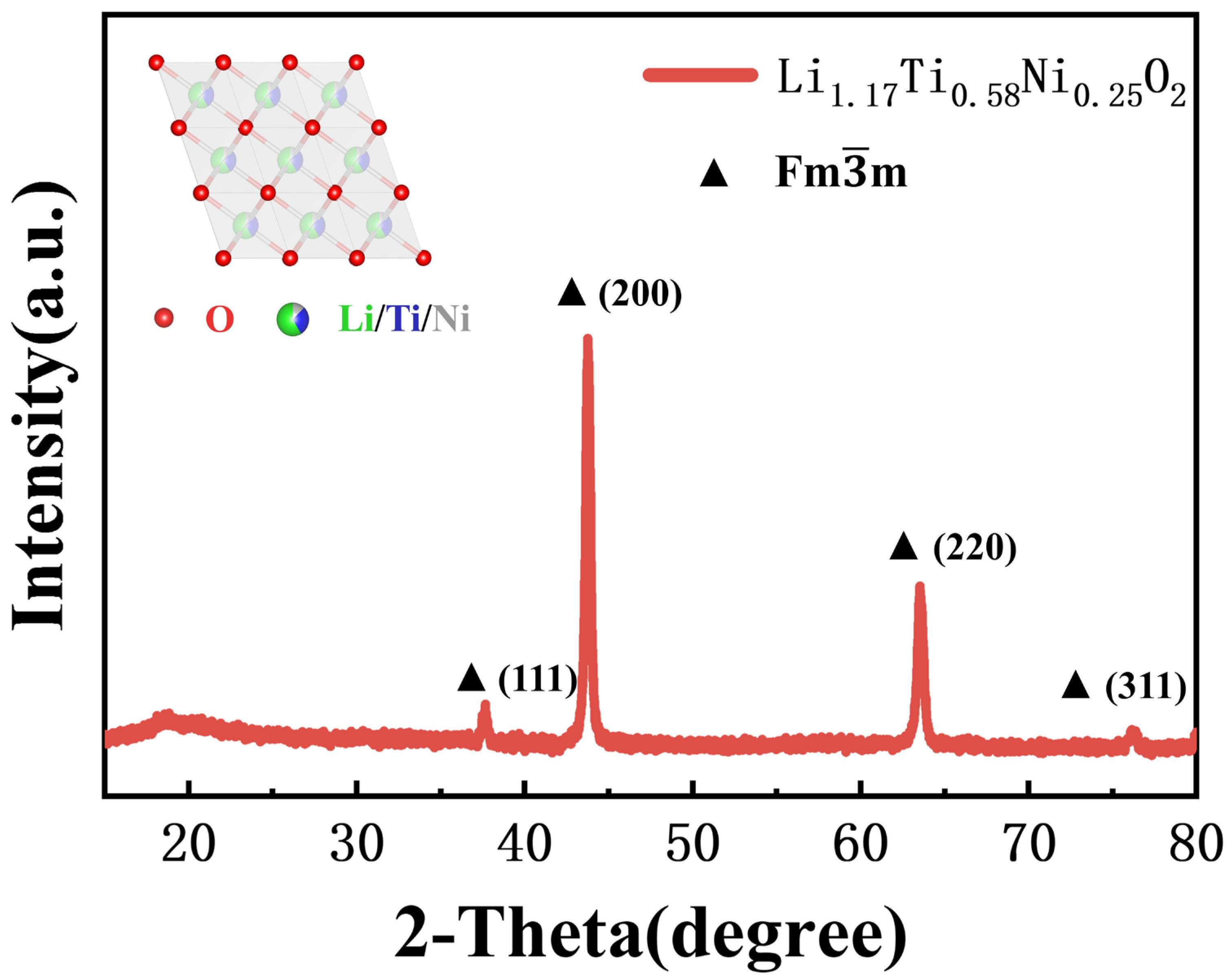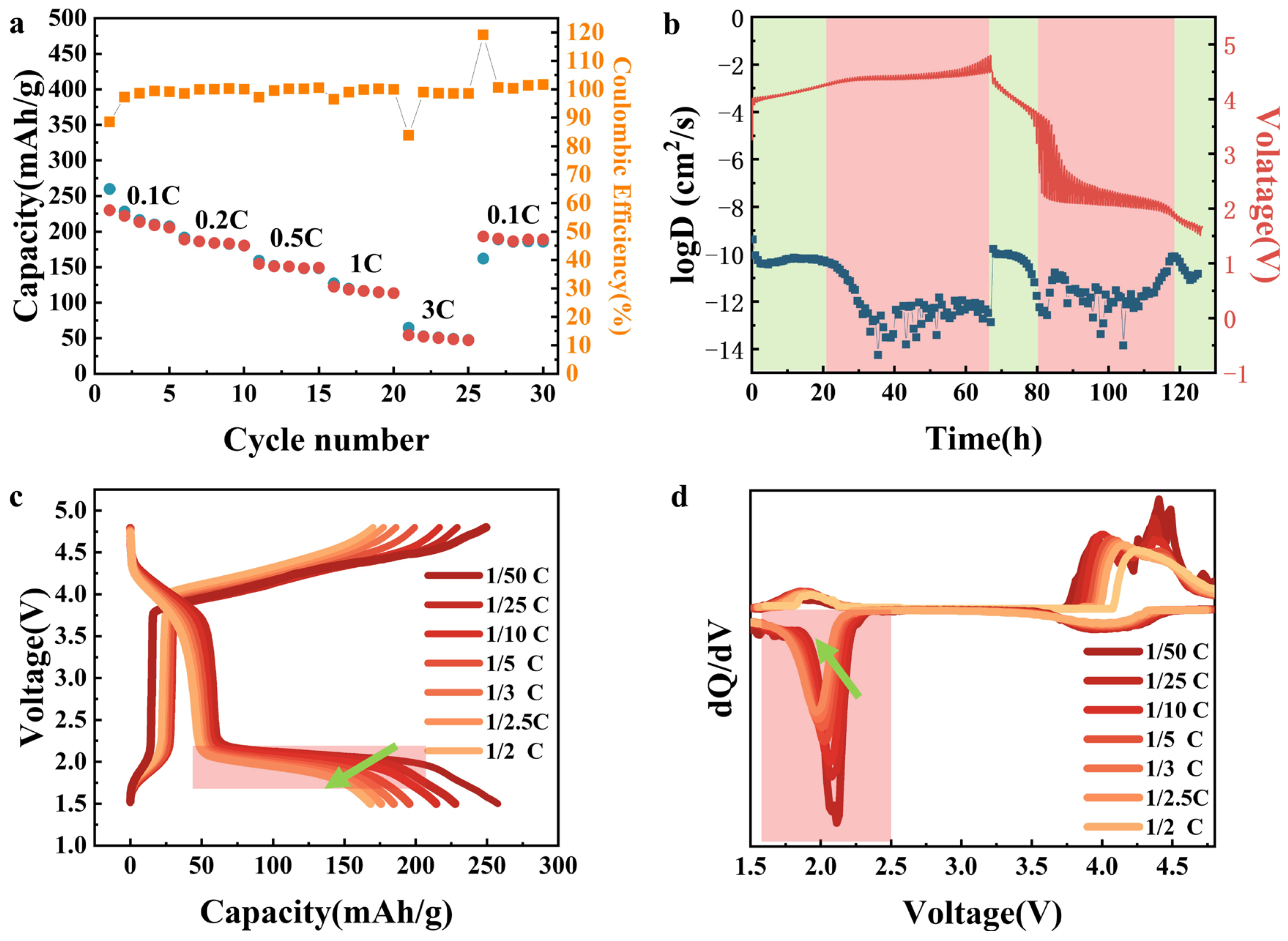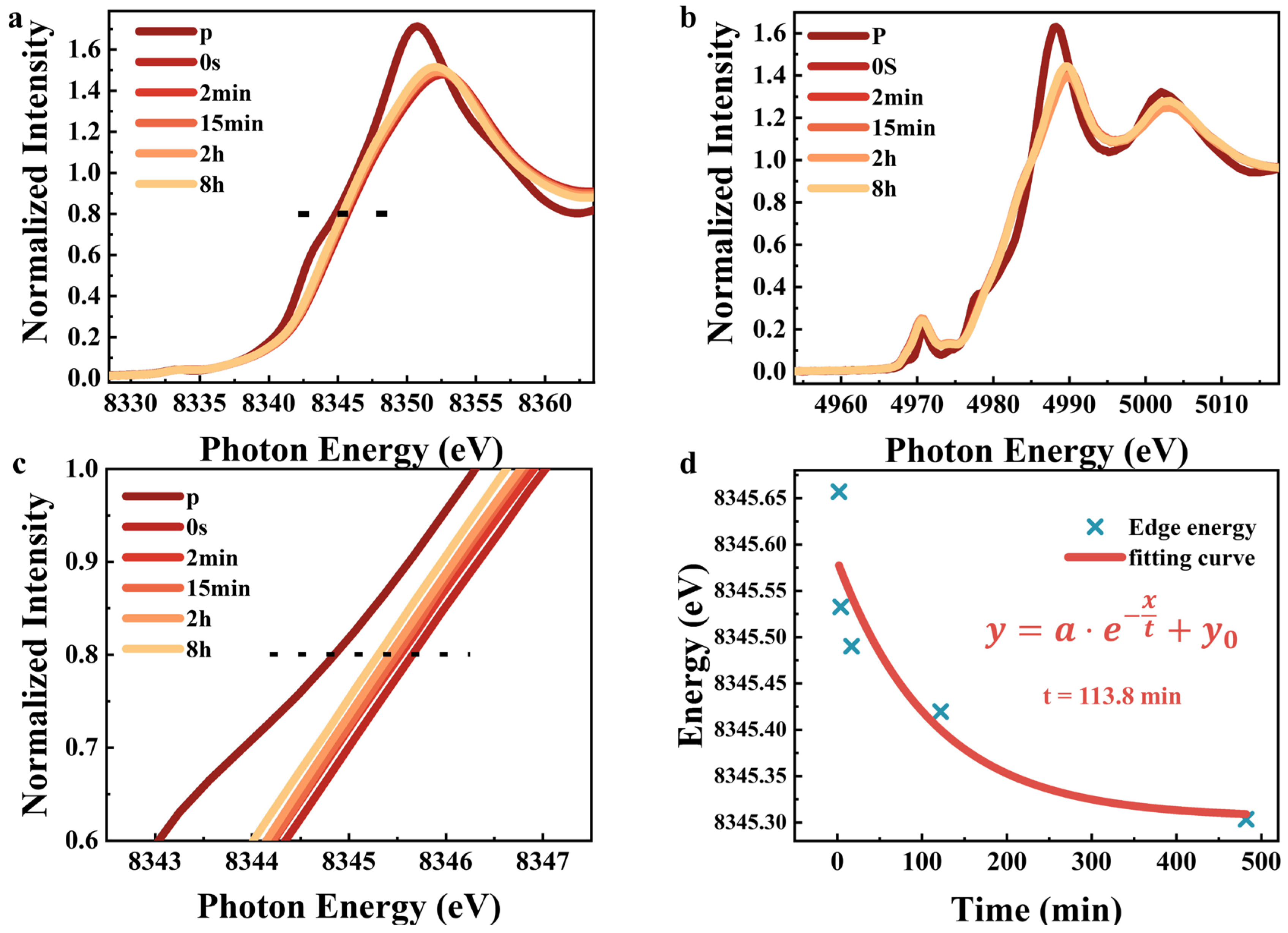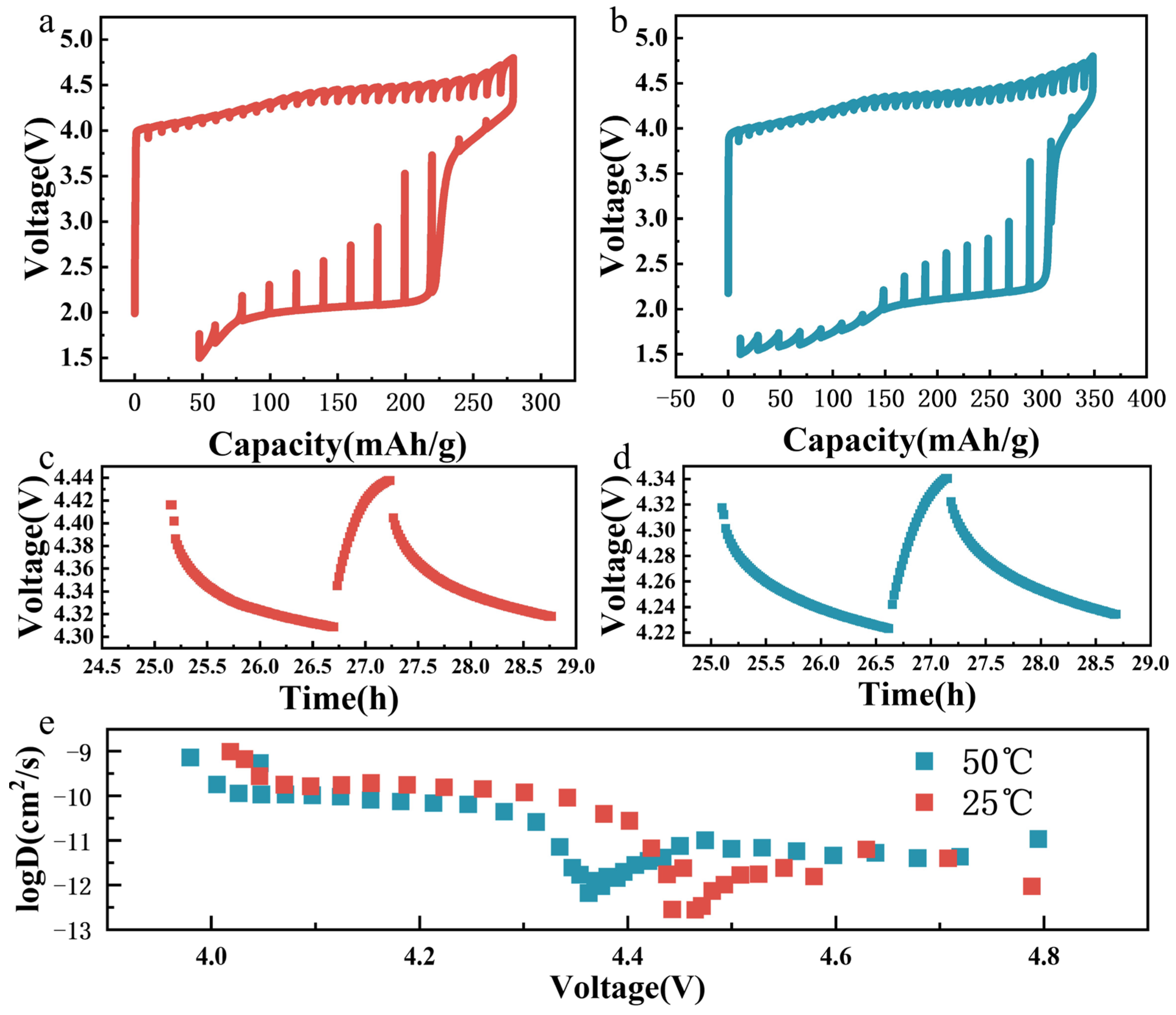Investigation on the Origin of Sluggish Anionic Redox Kinetics in Cation-Disordered Cathode
Abstract
:1. Introduction
2. Materials and Methods
2.1. Material Synthesis
2.2. Material Characterization
2.3. Electrochemical Measurements
3. Results
3.1. Structural Analysis
3.2. Electrochemical Performance Analysis
3.3. Charge Transfer between Transition Metal and Oxygen
3.4. Kinetic Analysis
4. Discussion
5. Conclusions
Supplementary Materials
Author Contributions
Funding
Data Availability Statement
Acknowledgments
Conflicts of Interest
References
- Wu, F.; Maier, J.; Yu, Y. Guidelines and trends for next-generation rechargeable lithium and lithium-ion batteries. Chem. Soc. Rev. 2020, 49, 1569–1614. [Google Scholar] [CrossRef] [PubMed]
- Gandoman, F.H.; Jaguemont, J.; Goutam, S.; Gopalakrishnan, R.; Firouz, Y.; Kalogiannis, T.; Omar, N.; Van Mierlo, J. Concept of reliability and safety assessment of lithium-ion batteries in electric vehicles: Basics, progress, and challenges. Appl. Energy 2019, 251, 113343. [Google Scholar] [CrossRef]
- He, W.; Guo, W.B.; Wu, H.L.; Lin, L.; Liu, Q.; Han, X.; Xie, Q.S.; Liu, P.F.; Zheng, H.F.; Wang, L.S.; et al. Challenges and Recent Advances in High Capacity Li-Rich Cathode Materials for High Energy Density Lithium-Ion Batteries. Adv. Mater. 2021, 33, 2005937. [Google Scholar] [CrossRef] [PubMed]
- Zhang, M.; Kitchaev, D.A.; Lebens-Higgins, Z.; Vinckeviciute, J.; Zuba, M.; Reeves, P.J.; Grey, C.P.; Whittingham, M.S.; Piper, L.F.J.; Van der Ven, A.; et al. Pushing the limit of 3d transition metal-based layered oxides that use both cation and anion redox for energy storage. Nat. Rev. Mater. 2022, 7, 522–540. [Google Scholar] [CrossRef]
- Assat, G.; Tarascon, J.-M. Fundamental understanding and practical challenges of anionic redox activity in Li-ion batteries. Nat. Energy 2018, 3, 373–386. [Google Scholar] [CrossRef]
- Jiao, S.C.; Wang, J.Y.; Hu, Y.S.; Yu, X.Q.; Li, H. High-Capacity Oxide Cathode beyond 300 mAh/g Focus Review. Acs Energy Lett. 2023, 8, 3025–3037. [Google Scholar] [CrossRef]
- Mukai, K.; Nonaka, T.; Uyama, T.; Nishimura, Y.F. In situ X-ray Raman spectroscopy and magnetic susceptibility study on the Li[Li0.15Mn1.85]O4 oxygen anion redox reaction. Chem. Commun. 2020, 56, 1701–1704. [Google Scholar] [CrossRef]
- Li, Q.; Li, H.; Xia, Q.; Hu, Z.; Zhu, Y.; Yan, S.; Ge, C.; Zhang, Q.; Wang, X.; Shang, X.; et al. Extra storage capacity in transition metal oxide lithium-ion batteries revealed by in situ magnetometry. Nat. Mater. 2020, 20, 76–83. [Google Scholar] [CrossRef]
- Li, Q.H.; Liang, Q.; Zhang, H.; Jiao, S.C.; Zhuo, Z.Q.; Wang, J.Y.; Li, Q.; Zhang, J.N.; Yu, X.Q. Unveiling the High-valence Oxygen Degradation across the Delithiated Cathode Surface. Angew. Chem.-Int. Ed. 2022, 62, e202215131. [Google Scholar] [CrossRef]
- Zhao, C.; Li, C.; Liu, H.; Qiu, Q.; Geng, F.; Shen, M.; Tong, W.; Li, J.; Hu, B. Coexistence of (O2)(n-) and Trapped Molecular O2 as the Oxidized Species in P2-Type Sodium 3d Layered Oxide and Stable Interface Enabled by Highly Fluorinated Electrolyte. J. Am. Chem. Soc. 2021, 143, 18652–18664. [Google Scholar] [CrossRef]
- Yabuuchi, N. Rational material design of Li-excess metal oxides with disordered rock salt structure. Curr. Opin. Electrochem. 2022, 34, 100978. [Google Scholar] [CrossRef]
- Clément, R.J.; Lun, Z.; Ceder, G. Cation-disordered rocksalt transition metal oxides and oxyfluorides for high energy lithium-ion cathodes. Energy Environ. Sci. 2020, 13, 345–373. [Google Scholar] [CrossRef]
- Lee, J.; Urban, A.; Li, X.; Su, D.; Hautier, G.; Ceder, G. Unlocking the Potential of Cation-Disordered Oxides for Rechargeable Lithium Batteries. Science 2014, 343, 519–522. [Google Scholar] [CrossRef] [PubMed]
- Chen, D.C.; Ahn, J.; Chen, G.Y. An Overview of Cation-Disordered Lithium-Excess Rocksalt Cathodes. Acs Energy Lett. 2021, 6, 1358–1376. [Google Scholar] [CrossRef]
- Hyun, H.; Yoon, H.; Choi, S.; Kim, J.; Kim, S.Y.; Regier, T.; Arthur, Z.; Kim, S.; Lim, J. Paradoxical role of structural degradation of nickel-rich layered oxides in capacity retention upon storage of lithium-ion batteries. Energy Environ. Sci. 2023, 16, 3968–3983. [Google Scholar] [CrossRef]
- Li, L.; Self, E.C.; Darbar, D.; Zou, L.; Bhattacharya, I.; Wang, D.; Nanda, J.; Wang, C. Hidden Subsurface Reconstruction and Its Atomic Origins in Layered Oxide Cathodes. Nano Lett. 2020, 20, 2756–2762. [Google Scholar] [CrossRef]
- Mu, L.; Lin, R.; Xu, R.; Han, L.; Xia, S.; Sokaras, D.; Steiner, J.D.; Weng, T.-C.; Nordlund, D.; Doeff, M.M.; et al. Oxygen Release Induced Chemomechanical Breakdown of Layered Cathode Materials. Nano Lett. 2018, 18, 3241–3249. [Google Scholar] [CrossRef]
- McColl, K.; House, R.A.; Rees, G.J.; Squires, A.G.; Coles, S.W.; Bruce, P.G.; Morgan, B.J.; Islam, M.S. Transition metal migration and O2 formation underpin voltage hysteresis in oxygen-redox disordered rocksalt cathodes. Nat. Commun. 2022, 13, 5275. [Google Scholar] [CrossRef]
- He, J.; Meng, J.; Huang, Y. Challenges and recent progress in fast-charging lithium-ion battery materials. J. Power Sources 2023, 570, 232965. [Google Scholar] [CrossRef]
- Jin, T.; Han, Q.; Wang, Y.; Jiao, L. 1D Nanomaterials: Design, Synthesis, and Applications in Sodium-Ion Batteries. Small 2018, 14, 1703086. [Google Scholar] [CrossRef]
- Balasankar, A.; Arthiya, S.; Ramasundaram, S.; Sumathi, P.; Arokiyaraj, S.; Oh, T.; Aruchamy, K.; Sriram, G.; Kurkuri, M. Recent Advances in the Preparation and Performance of Porous Titanium-Based Anode Materials for Sodium-Ion Batteries. Energies 2022, 15, 9495. [Google Scholar] [CrossRef]
- Aruchamy, K.; Balasankar, A.; Ramasundaram, S.; Oh, T.H. Recent Design and Synthesis Strategies for High-Performance Supercapacitors Utilizing ZnCo2O4-Based Electrode Materials. Energies 2023, 16, 5604. [Google Scholar] [CrossRef]
- Tang, X.; Xu, Z.; Sun, Z.; Zhou, J.; Wu, X.; Lin, H.; Rong, J.; Zhuo, S.; Li, F. Factors of Kinetics Processes in Lithium–Sulfur Reactions. Energy Technol. 2019, 7, 1900574. [Google Scholar] [CrossRef]
- Das, A.; Raj, B.; Mohapatra, M.; Andersen, S.M.; Basu, S. Performance and future directions of transition metal sulfide-based electrode materials towards supercapacitor/supercapattery. WIREs Energy Environ. 2022, 11, e414. [Google Scholar] [CrossRef]
- Zhao, S.; Guo, Z.; Yan, K.; Wan, S.; He, F.; Sun, B.; Wang, G. Towards high-energy-density lithium-ion batteries: Strategies for developing high-capacity lithium-rich cathode materials. Energy Storage Mater. 2021, 34, 716–734. [Google Scholar] [CrossRef]
- Sathiya, M.; Leriche, J.B.; Salager, E.; Gourier, D.; Tarascon, J.M.; Vezin, H. Electron paramagnetic resonance imaging for real-time monitoring of Li-ion batteries. Nat. Commun. 2015, 6, 6276. [Google Scholar] [CrossRef]
- Li, N.; Wu, J.; Hwang, S.; Papp, J.K.; Kan, W.H.; Zhang, L.; Zhu, C.; McCloskey, B.D.; Yang, W.; Tong, W. Enabling Facile Anionic Kinetics through Cationic Redox Mediator in Li-Rich Layered Cathodes. ACS Energy Lett. 2020, 5, 3535–3543. [Google Scholar] [CrossRef]
- Ku, K.; Kim, B.; Jung, S.-K.; Gong, Y.; Eum, D.; Yoon, G.; Park, K.-Y.; Hong, J.; Cho, S.-P.; Kim, D.-H.; et al. A new lithium diffusion model in layered oxides based on asymmetric but reversible transition metal migration. Energy Environ. Sci. 2020, 13, 1269–1278. [Google Scholar] [CrossRef]
- Wang, D.; Liu, Y.; Wu, Z.; Liu, Y.; Zhu, C.; Zhong, B.; Guo, X. Realizing discrepant oxygen-redox chemistry in honeycomb superlattice cathode via manipulating oxygen-stacking sequences. Chem. Eng. J. 2023, 462, 141994. [Google Scholar] [CrossRef]
- Huang, J.; Zhong, P.; Ha, Y.; Kwon, D.-H.; Crafton, M.J.; Tian, Y.; Balasubramanian, M.; McCloskey, B.D.; Yang, W.; Ceder, G. Non-topotactic reactions enable high rate capability in Li-rich cathode materials. Nat. Energy 2021, 6, 706–714. [Google Scholar] [CrossRef]
- Li, B.A.; Kumar, K.; Roy, I.; Morozov, A.V.; Emelyanova, O.V.; Zhang, L.T.; Koc, T.; Belin, S.; Cabana, J.; Dedryvere, R.; et al. Capturing dynamic ligand-to-metal charge transfer with a long-lived cationic intermediate for anionic redox. Nat. Mater. 2022, 21, 1165–1174. [Google Scholar] [CrossRef] [PubMed]
- Liu, Y.; Zheng, S.; Wan, H.; Dou, A.; Chu, D.; Su, M. Synthesis and electrochemical properties of cation-disordered Li-Ni-Ti-O compounds as cathode material for lithium ion batteries. J. Alloys Compd. 2017, 728, 659–668. [Google Scholar] [CrossRef]
- Zhang, Y.X.; Hu, A.Y.; Liu, J.; Xu, Z.R.; Mu, L.Q.; Sainio, S.; Nordlund, D.; Li, L.X.; Sun, C.J.; Xiao, X.H.; et al. Investigating Particle Size-Dependent Redox Kinetics and Charge Distribution in Disordered Rocksalt Cathodes. Adv. Funct. Mater. 2022, 32, 2110502. [Google Scholar] [CrossRef]
- Yu, Z.; Qu, X.; Dou, A.; Su, M.; Liu, Y.; Wu, F. Synthesis and Redox Mechanism of Cation-Disordered, Rock-Salt Cathode-Material Li-Ni-Ti-Nb-O Compounds for a Li-Ion Battery. ACS Appl. Mater. Interfaces 2019, 11, 35777–35787. [Google Scholar] [CrossRef] [PubMed]
- Tang, W.; Li, A.; Zhou, G.; Chen, Z.; Yang, Z.; Su, J.; Zhang, W. Structural Stabilization of Cation-Disordered Rock-Salt Cathode Materials: Coupling between a High-Ratio Inactive Ti4+ Cation and a Mn2+/Mn4+ Two-Electron Redox Pair. ACS Appl. Mater. Interfaces 2022, 14, 38865–38874. [Google Scholar] [CrossRef] [PubMed]
- Hwang, J.; Myeong, S.; Jin, W.; Jang, H.; Nam, G.; Yoon, M.; Kim, S.H.; Joo, S.H.; Kwak, S.K.; Kim, M.G.; et al. Excess-Li Localization Triggers Chemical Irreversibility in Li- and Mn-Rich Layered Oxides. Adv. Mater. 2020, 32, 2001944. [Google Scholar] [CrossRef] [PubMed]
- Sun, G.; Yu, F.-D.; Zhao, C.; Yu, R.; Farnum, S.; Shao, G.; Sun, X.; Wang, Z.-B. Decoupling the Voltage Hysteresis of Li-Rich Cathodes: Electrochemical Monitoring, Modulation Anionic Redox Chemistry and Theoretical Verifying. Adv. Funct. Mater. 2021, 31, 2002643. [Google Scholar] [CrossRef]
- House, R.A.; Rees, G.J.; McColl, K.; Marie, J.J.; Garcia-Fernandez, M.; Nag, A.; Zhou, K.J.; Cassidy, S.; Morgan, B.J.; Islam, M.S.; et al. Delocalized electron holes on oxygen in a battery cathode. Nat. Energy 2023, 8, 351–360. [Google Scholar] [CrossRef]
- Sathiya, M.; Rousse, G.; Ramesha, K.; Laisa, C.P.; Vezin, H.; Sougrati, M.T.; Doublet, M.L.; Foix, D.; Gonbeau, D.; Walker, W.; et al. Reversible anionic redox chemistry in high-capacity layered-oxide electrodes. Nat. Mater. 2013, 12, 827–835. [Google Scholar] [CrossRef]
- Li, B.; Sougrati, M.T.; Rousse, G.; Morozov, A.V.; Dedryvère, R.; Iadecola, A.; Senyshyn, A.; Zhang, L.; Abakumov, A.M.; Doublet, M.-L.; et al. Correlating ligand-to-metal charge transfer with voltage hysteresis in a Li-rich rock-salt compound exhibiting anionic redox. Nat. Chem. 2021, 13, 1070–1080. [Google Scholar] [CrossRef]
- Li, B.; Assat, G.; Pearce, P.E.; Nikitina, V.A.; Iadecola, A.; Delacourt, C.; Tarascon, J.-M. Exploring the Kinetic Limitations Causing Unusual Low-Voltage Li Reinsertion in Either Layered or Tridimensional Li2IrO3 Cathode Materials. Chem. Mater. 2020, 32, 2133–2147. [Google Scholar] [CrossRef]
- Seo, D.-H.; Lee, J.; Urban, A.; Malik, R.; Kang, S.; Ceder, G. The structural and chemical origin of the oxygen redox activity in layered and cation-disordered Li-excess cathode materials. Nat. Chem. 2016, 8, 692–697. [Google Scholar] [CrossRef] [PubMed]
- House, R.A.; Rees, G.J.; Pérez-Osorio, M.A.; Marie, J.-J.; Boivin, E.; Robertson, A.W.; Nag, A.; Garcia-Fernandez, M.; Zhou, K.-J.; Bruce, P.G. First-cycle voltage hysteresis in Li-rich 3d cathodes associated with molecular O2 trapped in the bulk. Nat. Energy 2020, 5, 777–785. [Google Scholar] [CrossRef]
- Zhuo, Z.; Dai, K.; Wu, J.; Zhang, L.; Tamura, N.; Chuang, Y.-d.; Feng, J.; Guo, J.; Shen, Z.-x.; Liu, G.; et al. Distinct Oxygen Redox Activities in Li2MO3 (M = Mn, Ru, Ir). ACS Energy Lett. 2021, 6, 3417–3424. [Google Scholar] [CrossRef]
- Wu, J.; Zhuo, Z.; Rong, X.; Dai, K.; Lebens-Higgins, Z.; Sallis, S.; Pan, F.; Piper Louis, F.J.; Liu, G.; Chuang, Y.-d.; et al. Dissociate lattice oxygen redox reactions from capacity and voltage drops of battery electrodes. Sci. Adv. 2020, 6, eaaw3871. [Google Scholar] [CrossRef]
- Zhou, J.; Chen, Z.; Yu, G.; Ma, K.; Lian, X.; Li, S.; Shi, Q.; Wang, J.; Guo, L.; Liu, Y.; et al. Accelerating O-Redox Kinetics with Carbon Nanotubes for Stable Lithium-Rich Cathodes. Small Methods 2022, 6, e2200449. [Google Scholar] [CrossRef]
- Yu, R.; Banis, M.N.; Wang, C.; Wu, B.; Huang, Y.; Cao, S.; Li, J.; Jamil, S.; Lin, X.; Zhao, F.; et al. Tailoring bulk Li+ ion diffusion kinetics and surface lattice oxygen activity for high-performance lithium-rich manganese-based layered oxides. Energy Storage Mater. 2021, 37, 509–520. [Google Scholar] [CrossRef]
- Tu, W.Q.; Wang, X.S.; Tian, W.Y.; Zhou, Y.N.; Han, C.P.; Li, C.; Kang, F.Y.; Li, B.H. A green water-induced spinel heterostructure interface enabling high performance lithium and manganese rich oxides. J. Mater. Chem. A 2021, 9, 20576–20584. [Google Scholar] [CrossRef]
- Ren, H.; Li, Y.; Ni, Q.; Bai, Y.; Zhao, H.; Wu, C. Unraveling Anionic Redox for Sodium Layered Oxide Cathodes: Breakthroughs and Perspectives. Adv. Mater. 2022, 34, e2106171. [Google Scholar] [CrossRef]
- Lin, H.; Moreno, B.; Kucuk, K.; Zhang, S.; Aryal, S.; Li, Z.; Segre, C.U.; Rodriguez, J.; Puthusseri, D.; Cai, L.; et al. Fundamental understanding of high-capacity lithium-excess cathodes with disordered rock salt structure. J. Mater. Sci. Technol. 2021, 74, 60–68. [Google Scholar] [CrossRef]
- Rodrigues, M.-T.F.; Babu, G.; Gullapalli, H.; Kalaga, K.; Sayed, F.N.; Kato, K.; Joyner, J.; Ajayan, P.M. A materials perspective on Li-ion batteries at extreme temperatures. Nat. Energy 2017, 2, 17108. [Google Scholar] [CrossRef]
- Alberi, K.; Nardelli, M.B.; Zakutayev, A.; Mitas, L.; Curtarolo, S.; Jain, A.; Fornari, M.; Marzari, N.; Takeuchi, I.; Green, M.L.; et al. The 2019 materials by design roadmap. J. Phys. D Appl. Phys. 2019, 52, 013001. [Google Scholar] [CrossRef] [PubMed]





Disclaimer/Publisher’s Note: The statements, opinions and data contained in all publications are solely those of the individual author(s) and contributor(s) and not of MDPI and/or the editor(s). MDPI and/or the editor(s) disclaim responsibility for any injury to people or property resulting from any ideas, methods, instructions or products referred to in the content. |
© 2023 by the authors. Licensee MDPI, Basel, Switzerland. This article is an open access article distributed under the terms and conditions of the Creative Commons Attribution (CC BY) license (https://creativecommons.org/licenses/by/4.0/).
Share and Cite
Liang, Q.; Li, P.; Zhao, Y.; Chen, S.; Yin, J.; Lyu, Y.; Li, Q.; Li, Q. Investigation on the Origin of Sluggish Anionic Redox Kinetics in Cation-Disordered Cathode. Energies 2023, 16, 6740. https://doi.org/10.3390/en16186740
Liang Q, Li P, Zhao Y, Chen S, Yin J, Lyu Y, Li Q, Li Q. Investigation on the Origin of Sluggish Anionic Redox Kinetics in Cation-Disordered Cathode. Energies. 2023; 16(18):6740. https://doi.org/10.3390/en16186740
Chicago/Turabian StyleLiang, Qi, Peirong Li, Yue Zhao, Supeng Chen, Jixiang Yin, Yingchun Lyu, Qiang Li, and Qinghao Li. 2023. "Investigation on the Origin of Sluggish Anionic Redox Kinetics in Cation-Disordered Cathode" Energies 16, no. 18: 6740. https://doi.org/10.3390/en16186740






